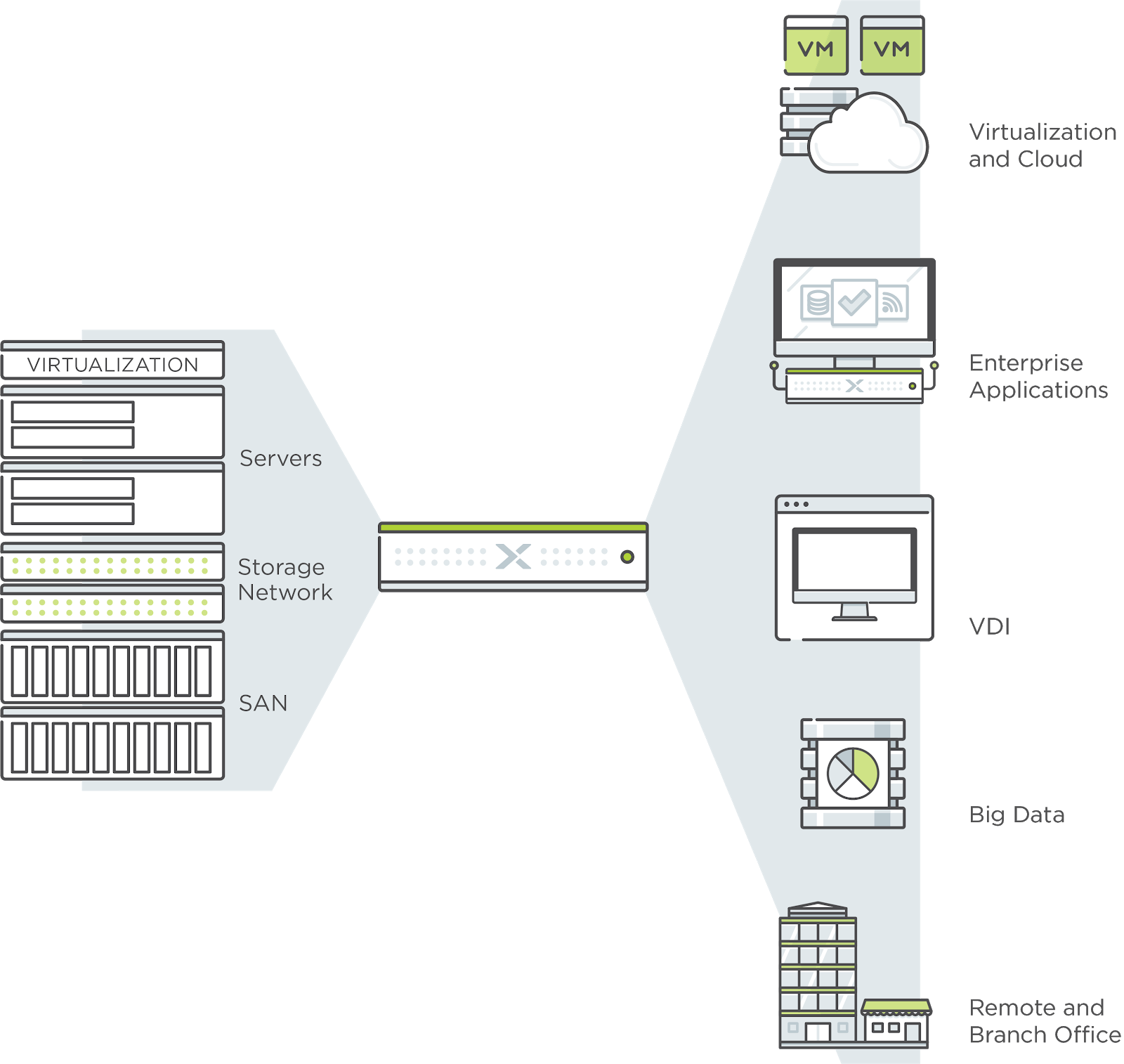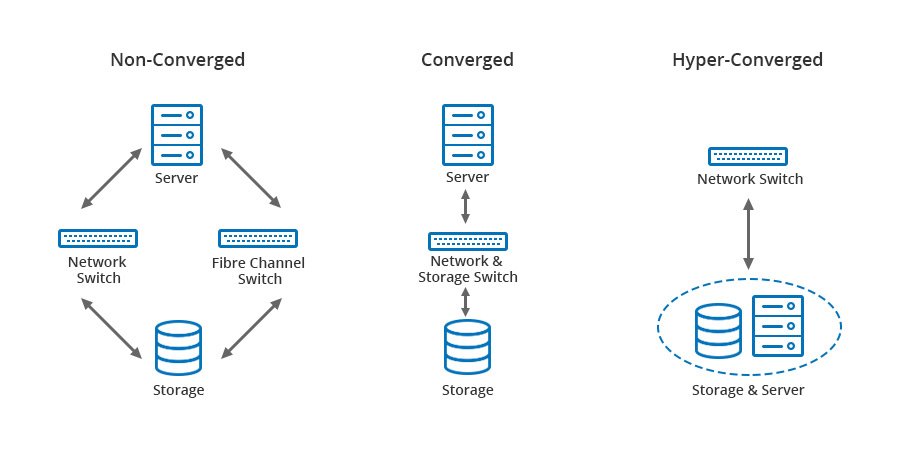Hyperconverged Infrastructure: A Brief Introduction
HCI reduces the variety of systems to be handled, the time invested in creating and constructing IT systems and deploying a big number of applications, while mitigating the intricacy of integrating numerous disparate resources. HCI combines product information center server hardware with in your area attached storage (frequently flash) that is powered by a dispersed software layer, which disperses all running functions throughout a cluster (multiple nodes) for superior performance and resilience.
Virtualization software application abstracts and swimming pools the underlying resources of the node. To optimize efficiency, the software application dynamically designates resources to applications running within virtual devices (VMs) or containers. By using a native hypervisor on the node or cluster, the underlying storage is architected and embedded straight within the hypervisor, removing the requirement for ineffective storage procedures, file systems and virtual storage home appliances (VSAs).
The most recent generations of x86 servers provide broad compatibility to support a wide variety of software development needs while their reliability and scalability (in part due to high-performance network, computing and storage abilities) make them ideal for application hosting. HCI is created to fix challenges brought about by a traditional 3-tiered architecture (3-tiered architecture is the use of independent servers, storage and networking elements).
Conventional architecture layers require their own management systems, private support services, trainings and accreditations. Compatibility in between suppliers is a consistent obstacle. For example, companies need to ensure that supplier X’s latest upgrade is suitable with vendor Y’s and so on. HCI helps organizations to: Quickly manage heterogenous work on a single cluster.
 Disaster Recovery Planning for Hyper-Converged Infrastructure — Virtualization Review
Disaster Recovery Planning for Hyper-Converged Infrastructure — Virtualization Reviewright here about
Hyperconverged infrastructure will evolve into cloud building
https://valleypconline.com/community/profile/linniedellit356/.
Dynamically adjust to altering resource requirements. Autonomously monitor quality of service, thereby speeding resolution of issues that might arise. Rapidly scale computing and storage by adding more nodes to existing clusters, Https://www.Temakids.Com/community/profile/Cathleenpoland/ without application or services downtime. Establish policy-based management that enables admins to define storage needs for a given work.
Upgrade Outdated hardware Infrastructure
Control costs: Dynamic resource allotment optimizes physical and professional resources to lower costs while satisfying growing organizational demand and the SLAs around IT services. HCI helps manage capital expenditures and recurring expenditures. HCI uses industry-standard elements (e. g., x86 servers, 10GB ethernet, and so on) instead of purpose-built storage varieties and fiber channel networking to drive expense efficiencies beginning at procurement.
Hyperconverged infrastructure leverages automation to deliver operational efficiencies. Software enables rapid deployment of cloud facilities, eliminates manual jobs like provisioning and handling storage and automates processes like patching, updating and updating infrastructure. Numerous HCI vendors provide continuous licensing that carries through numerous facilities refreshes and keeps support at a repaired expense.
Constant infrastructure operations are essential to running and managing applications in between environments. HCI provides a singular design for infrastructure operations by delivering vibrant capacity, consolidating on-premises infrastructure and offering the capability to establish and evaluate brand-new applications. Taking a typical method breeds consistency and simpleness enabling quick deployment of brand-new VMs, Hyperconverged Infrastructure Part 2 – What’s Included containers and next-generation devices.
A few of the advantages of HCI are: Increased IT effectiveness: Computing, storage and networking resources are hosted in a single location, which indicates less systems and vendors to manage. Automation in HCI removes manual processes, which increases efficiency and conserves IT time. Minimized storage and expenses: HCI enables services to prevent big upfront costs by using industry-standard x86 servers and scaling the information center capacity as required.
Streamlined implementation: HCI services are offered in enhanced, pre-defined packages, so businesses can just acquire and run them. HCI enables centralized management of all virtual environments through a single user interface, which simplifies system management. Boosted efficiency: With HCI, companies can release numerous applications and work without stressing over decreased efficiency.
Hyperconverged Appliance
Enhanced versatility and scalability: HCI makes use of a building-block approach that enables businesses to quickly scale by just including systems as per their service requirements. Advanced security: Hyperconvergence software application is constructed to anticipate and manage hardware failure to boost information protection. Numerous HCI vendors use AES-256 software encryption, self-encrypting drives (SEDs) and built-in crucial management functions to get rid of the requirement for third-party software application, representatives or scripting.
A snapshot saves point-in-time virtual copy of virtual machine (VM) data including the VM’s power state, disk, memory, virtual network interface cards (virtual NICs/v, NICs) and files. Snapshots are typically utilized as a failsafe rollback point prior to performing system upgrades, changing installed software application or installing/uninstalling other components. They work for advancement purposes, because they can be used repeatedly in a «rinse and repeat» style throughout advancement and software application recognition cycles.
Finest practices from among the biggest hypervisor suppliers in the market, VMware, plainly discusses the intent and purpose of pictures and they are not meant as backups. Some of the limitations include: VMware encourages not to surpass an optimum of 32 snapshots in a chain. For best efficiency, they suggest 2-3.
Snapshot files’ size increases the longer the picture is retained. This impacts system performance and might cause storage areas to run out of area more rapidly. Alternatively, backup files are produced independently of the virtual maker. While most modern backup technologies utilize the VM picture to copy data, they do not rely on the picture staying in place.
 Hyperconverged Infrastructure Helixstorm
Hyperconverged Infrastructure HelixstormBackups are easily exported and saved on secondary media or replicated to a secondary target to be kept in a warm state, easily offered for www.astrocarma.com recovery. Backups are a vital part of organization continuity, allowing healing time goals (RTOs) and recovery point goals (RPOs) to be satisfied. Pictures do not make sure either of those objectives.
Hyperconverged infrastructure will evolve into cloud building
 VxRail Hyper-Converged Infrastructure Appliance Dell Technologies US
VxRail Hyper-Converged Infrastructure Appliance Dell Technologies USUnitrends delivers innovative recovery functions that go far beyond the abilities of snapshots, including granular item healing, immediate healing for VMs and Windows servers, automated application-level recovery testing and more. Incorporate with Unitrends Cloud for cost-efficient long-lasting retention and Https://heliumtokentalk.Com/profile/levifloyd89053/ Disaster Recovery-as-a-Service (DRaa, S) to spin up essential workloads in the event of a site-wide catastrophe.
A hyperconverged infrastructure (HCI) service is a primary tool for linking, handling and operating interconnected enterprise systems in a hyperconverged infrastructure (HCI). The technology helps organizations virtualize storage, servers, and https://Valleypconline.com/community/profile/linniedellit356/ networks. While converged facilities uses hardware to accomplish this goal, HCI takes a software-centric technique. To be sure, Build your own Hyper Converged Appliance hyperconvergence has its benefits and drawbacks.
By virtualizing parts it’s possible to construct more effective databases, storage systems, server frameworks and more. HCI solutions increasingly extend from the data center to the edge. Numerous likewise include expert system and artificial intelligence to constantly enhance, adjust and adapt to fast-changing business conditions. Some also consist of self-healing functions.
This can result in a lower total cost of ownership (TCO). Generally, HCI environments utilize a hypervisor, typically working on a server that utilizes direct-attached storage (DAS), to create a data center swimming pool of systems and resources. Most support heterogenous software and hardware systems. Completion outcome is a more flexible, agile and scalable computing structure that makes it simpler to construct and manage personal cloud, public clouds and hybrid clouds.
These consist of: Organizations have vastly various requirements when it concerns linking existing infrastructure, clouds and edge services. For example, an organization might require just the storage layer in the cloud. Or it might want to duplicate or transform configurations when changing cloud suppliers. Preferably, an HCI option allows a business to alter, upgrade and adjust as infrastructure requires modification.
